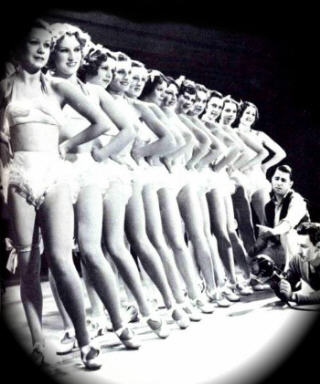
America's First Dance
Directors |
| The 1920's |

Gertrude Hoffman Gertrude Hoffman was a vaudeville dancer who did popular versions of the modern dance presentations of Loie Fuller and Isadora Duncan. As one of New York's first women choreographers, she specialized in chorus lines and special effects. The repertory of Gertrude Hoffman girls featured acrobatic numbers and synchronized fencing drills along with standard fare like high-kicking routines. The Gertrude Hoffman girls represented a brave, new, athletic manifestation of the American chorus girl, with a hybrid style that embraced the precision of Tiller and the freedom of Duncan. Ned Wayburn
Ned Wayburn was the most prolific, outspoken
and influential American dance director of the first three decades of the
twentieth century. His carreer spanned forty-one years, more than six hundred
London and New York stage productions, and an incalculable number of vaudeville
acts. Wayburn's best known stagings included THE PASSING SHOW OF 1912 and 1913,
THE ZIEGFELD FOLLIES from 1916 to 1919 and 1922 and 1923, and the Lew Fields
musical comedy THE POOR LITTLE RITZ GIRL.
Bobby Connolly supervised the "leg and ankle
work" and devised the "trick dance routines" for such shows as THE NEW MOON
and FUNNY FACE. Bobby Connolly made tap dancing popular by favoring its use
in chorus routines, but is perhaps best remembered for his work on GOOD NEWS
in which he created the very famous "Varsity Drag". Sammy Lee was a very popular dance director in the 1920's, who advocated extensive dancer training. For him improvements in the musical shows themselves demanded more strenuous, intricate and acrobatic routines that only skillfully trained dancers could master. Undoubtedly, increased competition among the many new women who sought stage careers during the liberated 1920's helped raise lax standards. Sammy Lee reported that "for the chorus of former years a stage manager could select one out of three applicants: but I tried out more than a hundred girls before selecting the dancing octette in THE GINGHAM GIRL".
David Bennett's chief claim to fame was his creation of the "Domino" routine. This was a surefire contrivance made use of by many of Bennett's contemporaries and successors for ending a dance number, which consisted of lining the dancers up in a row, allowing the first to fall over, causing each member of the line to fall over sequentially.
Leroy Prinz is credited with breaking the unison effect of the chorus line by selecting different steps for different dancers in the line, an accomplishment as much a reflection of sophisticated spatial manipulation as a clever division of labor among dancers of unequal ability. Prinz called this technique the "conglomeration effect" and described it as "a matter of every dancer going to town and doing something different usually for the last sixteen or thirty-two bars of music."

The Busby Berkely Girls Busby Berkely Busby Berkely experimented with breaking up the static chorus line to great effect. He also experimented with multiple rhythms and synchopation. Berkely went on to stage many famous fantastical dance sequences for countless movie musicals.
Seymour Felix, who choreographed the Rodgers
and Hart shows PEGGY-ANN (1926) and SIMPLE SIMON (1930), was the earliest
to express publicly a more creatively ambitious, theatrically integral, and
dramatically motivated vision of show dance than had ever been encountered
on the commercial dance scene.
Albertina Rasch's concepts nourished uncommonly
experimental show dancing. She had a commercially successful carreer based
in formal ballet that spanned three decades of American show business and
included such major critical and commercial hits as RIO RITA (1927) THE BAND
WAGON (1931) and LADY IN THE DARK (1941). |
